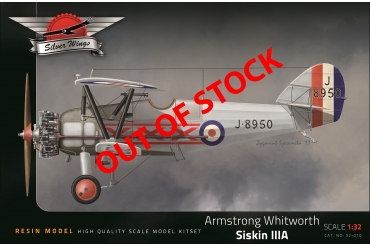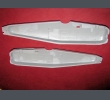Armstrong Whitworth Siskin IIIA
-
 Box
Box
-
 J-8959, 43 Squadron, Tangmere, 1930
J-8959, 43 Squadron, Tangmere, 1930
-
 J-8950, 29 Squadron, Duxford, 1929
J-8950, 29 Squadron, Duxford, 1929
History
The Armstrong Whitworth Siskin IIIA was a British biplane single-seat fighter aircraft of the 1920s produced by Armstrong Whitworth Aircraft. The Siskin, arguably one of the least attractive of all interwar RAF biplanes was nonetheless one of the most prolific with at least 450 examples being built (340 IIA's). By comparison with the Siskin III, the Siskin IIIA introduced a number of major design changes, including a lengthened fuselage with raised aft decking, less upper wing dihedral, and redesigned vertical tail surfaces lacking the lower ventral fin.
It was first introduced into Royal Air Force service in 1924 and was powered by an Armstrong Siddeley Jaguar radial engine. The Siskin IIIA entered RAF service with No.111 (Fighter) Squadron at Duxford in September 1926 and was followed by ten others, all UK-based; Nos.1, 17, 19, 25, 29, 32, 41, 43, 54 and 56. The type was retired from front-line RAF service in October 1932, being replaced by the Bristol Bulldog. The Siskin IIIA first flew on 20 October 1925, and was ordered for the RAF in June 1926, 412 being built, including 47 dual-control trainers, 17 of the single-seaters being supplied to the RCAF. Of the total production, the parent company built 159 (Blackburn building 42, Bristol 85, Gloster 74 and Vickers 52). The only other country to fly the Siskin was the RCAF, which received 12 examples. Some of these survived until June 1939 when they were put into storage at High River. The last was struck offRCAFcharge inAugust 1947. Unfortunately, no Siskins survive today.
Technical data:
Crew: 1
Length: 7,72 m
Wingspan: 10,11 m
Height: 3,10 m
Wing area: 27,22 m
Empty weight: 935 kg
Max takeoff weight: 1,366 kg
Power plant: 1 × Armstrong Siddeley Jaguar IV radial engine, 385 hp
Maximum speed: 251 km/h at sea level
Range: 450 km
Service ceiling: 8,230 m
Armament: 2 × 7,7 mm Vickers machine guns
Provision for up to 4 × 9 kg bombs under wings



















